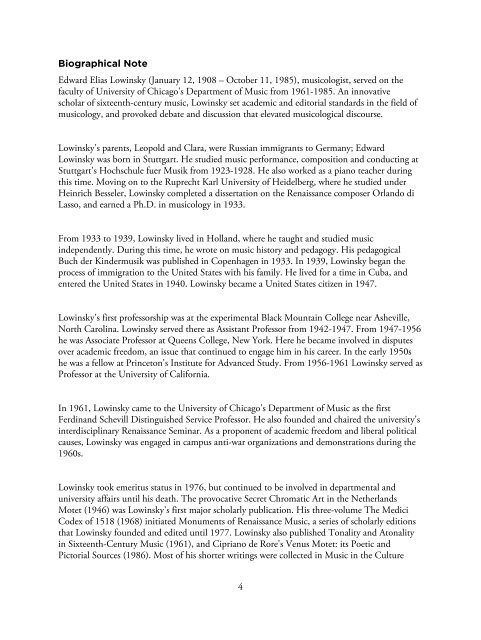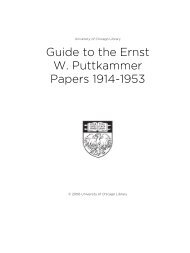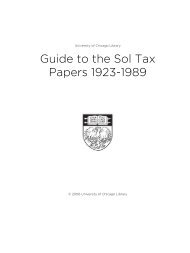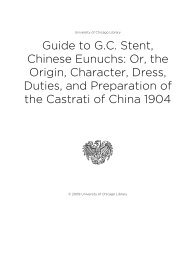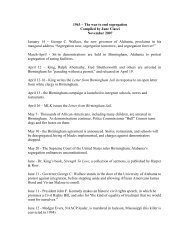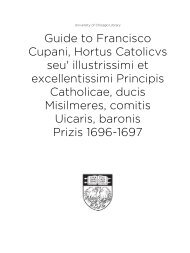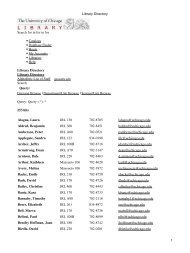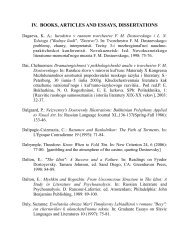Guide to the Edward E. Lowinsky Papers 1920-1986
Guide to the Edward E. Lowinsky Papers 1920-1986
Guide to the Edward E. Lowinsky Papers 1920-1986
Create successful ePaper yourself
Turn your PDF publications into a flip-book with our unique Google optimized e-Paper software.
Biographical Note<br />
<strong>Edward</strong> Elias <strong>Lowinsky</strong> (January 12, 1908 – Oc<strong>to</strong>ber 11, 1985), musicologist, served on <strong>the</strong><br />
faculty of University of Chicago's Department of Music from 1961-1985. An innovative<br />
scholar of sixteenth-century music, <strong>Lowinsky</strong> set academic and edi<strong>to</strong>rial standards in <strong>the</strong> field of<br />
musicology, and provoked debate and discussion that elevated musicological discourse.<br />
<strong>Lowinsky</strong>'s parents, Leopold and Clara, were Russian immigrants <strong>to</strong> Germany; <strong>Edward</strong><br />
<strong>Lowinsky</strong> was born in Stuttgart. He studied music performance, composition and conducting at<br />
Stuttgart's Hochschule fuer Musik from 1923-1928. He also worked as a piano teacher during<br />
this time. Moving on <strong>to</strong> <strong>the</strong> Ruprecht Karl University of Heidelberg, where he studied under<br />
Heinrich Besseler, <strong>Lowinsky</strong> completed a dissertation on <strong>the</strong> Renaissance composer Orlando di<br />
Lasso, and earned a Ph.D. in musicology in 1933.<br />
From 1933 <strong>to</strong> 1939, <strong>Lowinsky</strong> lived in Holland, where he taught and studied music<br />
independently. During this time, he wrote on music his<strong>to</strong>ry and pedagogy. His pedagogical<br />
Buch der Kindermusik was published in Copenhagen in 1933. In 1939, <strong>Lowinsky</strong> began <strong>the</strong><br />
process of immigration <strong>to</strong> <strong>the</strong> United States with his family. He lived for a time in Cuba, and<br />
entered <strong>the</strong> United States in 1940. <strong>Lowinsky</strong> became a United States citizen in 1947.<br />
<strong>Lowinsky</strong>'s first professorship was at <strong>the</strong> experimental Black Mountain College near Asheville,<br />
North Carolina. <strong>Lowinsky</strong> served <strong>the</strong>re as Assistant Professor from 1942-1947. From 1947-1956<br />
he was Associate Professor at Queens College, New York. Here he became involved in disputes<br />
over academic freedom, an issue that continued <strong>to</strong> engage him in his career. In <strong>the</strong> early 1950s<br />
he was a fellow at Prince<strong>to</strong>n's Institute for Advanced Study. From 1956-1961 <strong>Lowinsky</strong> served as<br />
Professor at <strong>the</strong> University of California.<br />
In 1961, <strong>Lowinsky</strong> came <strong>to</strong> <strong>the</strong> University of Chicago's Department of Music as <strong>the</strong> first<br />
Ferdinand Schevill Distinguished Service Professor. He also founded and chaired <strong>the</strong> university's<br />
interdisciplinary Renaissance Seminar. As a proponent of academic freedom and liberal political<br />
causes, <strong>Lowinsky</strong> was engaged in campus anti-war organizations and demonstrations during <strong>the</strong><br />
1960s.<br />
<strong>Lowinsky</strong> <strong>to</strong>ok emeritus status in 1976, but continued <strong>to</strong> be involved in departmental and<br />
university affairs until his death. The provocative Secret Chromatic Art in <strong>the</strong> Ne<strong>the</strong>rlands<br />
Motet (1946) was <strong>Lowinsky</strong>'s first major scholarly publication. His three-volume The Medici<br />
Codex of 1518 (1968) initiated Monuments of Renaissance Music, a series of scholarly editions<br />
that <strong>Lowinsky</strong> founded and edited until 1977. <strong>Lowinsky</strong> also published Tonality and A<strong>to</strong>nality<br />
in Sixteenth-Century Music (1961), and Cipriano de Rore's Venus Motet: its Poetic and<br />
Pic<strong>to</strong>rial Sources (<strong>1986</strong>). Most of his shorter writings were collected in Music in <strong>the</strong> Culture<br />
4


